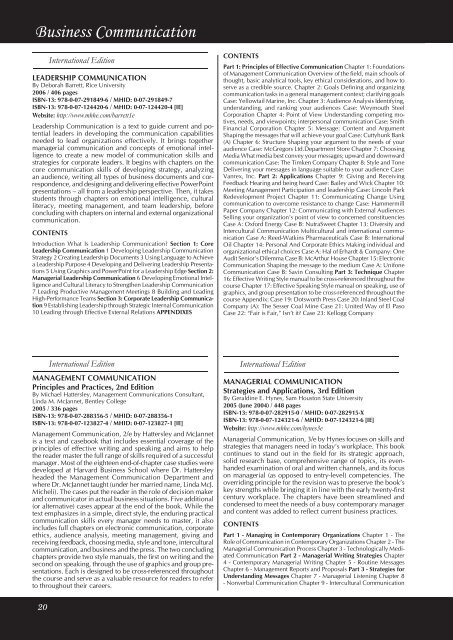Business Communication - McGraw-Hill Books
Business Communication - McGraw-Hill Books
Business Communication - McGraw-Hill Books
Create successful ePaper yourself
Turn your PDF publications into a flip-book with our unique Google optimized e-Paper software.
<strong>Business</strong> <strong>Communication</strong>International EditionLEADERSHIP COMMUNICATIONBy Deborah Barrett, Rice University2006 / 406 pagesISBN-13: 978-0-07-291849-6 / MHID: 0-07-291849-7ISBN-13: 978-0-07-124420-6 / MHID: 0-07-124420-4 [IE]Website: http://www.mhhe.com/barrett1eLeadership <strong>Communication</strong> is a text to guide current and potentialleaders in developing the communication capabilitiesneeded to lead organizations effectively. It brings togethermanagerial communication and concepts of emotional intelligenceto create a new model of communication skills andstrategies for corporate leaders. It begins with chapters on thecore communication skills of developing strategy, analyzingan audience, writing all types of business documents and correspondence,and designing and delivering effective PowerPointpresentations – all from a leadership perspective. Then, it takesstudents through chapters on emotional intelligence, culturalliteracy, meeting management, and team leadership, beforeconcluding with chapters on internal and external organizationalcommunication.CONTENTSIntroduction What Is Leadership <strong>Communication</strong>? Section 1: CoreLeadership <strong>Communication</strong> 1 Developing Leadership <strong>Communication</strong>Strategy 2 Creating Leadership Documents 3 Using Language to Achievea Leadership Purpose 4 Developing and Delivering Leadership Presentations5 Using Graphics and PowerPoint for a Leadership Edge Section 2:Managerial Leadership <strong>Communication</strong> 6 Developing Emotional Intelligenceand Cultural Literacy to Strengthen Leadership <strong>Communication</strong>7 Leading Productive Management Meetings 8 Building and LeadingHigh-Performance Teams Section 3: Corporate Leadership <strong>Communication</strong>9 Establishing Leadership through Strategic Internal <strong>Communication</strong>10 Leading through Effective External Relations APPENDIXESCONTENTSPart 1: Principles of Effective <strong>Communication</strong> Chapter 1: Foundationsof Management <strong>Communication</strong> Overview of the field, main schools ofthought, basic analytical tools, key ethical considerations, and how toserve as a credible source. Chapter 2: Goals Defining and organizingcommunication tasks in a general management context; clarifying goalsCase: Yellowtail Marine, Inc. Chapter 3: Audience Analysis Identifying,understanding, and ranking your audiences Case: Weymouth SteelCorporation Chapter 4: Point of View Understanding competing motives,needs, and viewpoints; interpersonal communication Case: SmithFinancial Corporation Chapter 5: Message: Content and ArgumentShaping the messages that will achieve your goal Case: Cuttyhunk Bank(A) Chapter 6: Structure Shaping your argument to the needs of youraudience Case: McGregors Ltd.Department Store Chapter 7: ChoosingMedia What media best convey your messages; upward and downwardcommunication Case: The Timken Company Chapter 8: Style and ToneDelivering your messages in language suitable to your audience Case:Vanrex, Inc. Part 2: Applications Chapter 9: Giving and ReceivingFeedback Hearing and being heard Case: Bailey and Wick Chapter 10:Meeting Management Participation and leadership Case: Lincoln ParkRedevelopment Project Chapter 11: Communicating Change Usingcommunication to overcome resistance to change Case: HammermillPaper Company Chapter 12: Communicating with External AudiencesSelling your organization’s point of view to concerned constituenciesCase A: Oxford Energy Case B: NutraSweet Chapter 13: Diversity andIntercultural <strong>Communication</strong> Multicultural and international communicationCase A: Reed-Watkins Pharmaceuticals Case B: InternationalOil Chapter 14: Personal And Corporate Ethics Making individual andorganizational ethical choices Case A: Hal of Erhardt & Company: OneAudit Senior’s Dilemma Case B: McArthur House Chapter 15: Electronic<strong>Communication</strong> Shaping the message to the medium Case A: Unifone<strong>Communication</strong> Case B: Savin Consulting Part 3: Technique Chapter16: Effective Writing Style manual to be cross-referenced throughout thecourse Chapter 17: Effective Speaking Style manual on speaking, use ofgraphics, and group presentation to be cross-referenced throughout thecourse Appendix: Case 19: Dotsworth Press Case 20: Inland Steel CoalCompany (A): The Sesser Coal Mine Case 21: United Way of El PasoCase 22: “Fair is Fair,” Isn’t it? Case 23: Kellogg CompanyInternational EditionMANAGEMENT COMMUNICATIONPrinciples and Practices, 2nd EditionBy Michael Hattersley, Management <strong>Communication</strong>s Consultant,Linda M. McJannet, Bentley College2005 / 336 pagesISBN-13: 978-0-07-288356-5 / MHID: 0-07-288356-1ISBN-13: 978-0-07-123827-4 / MHID: 0-07-123827-1 [IE]Management <strong>Communication</strong>, 2/e by Hattersley and McJannetis a text and casebook that includes essential coverage of theprinciples of effective writing and speaking and aims to helpthe reader master the full range of skills required of a successfulmanager. Most of the eighteen end-of-chapter case studies weredeveloped at Harvard <strong>Business</strong> School where Dr. Hattersleyheaded the Management <strong>Communication</strong> Department andwhere Dr. McJannet taught (under her married name, Linda McJ.Micheli). The cases put the reader in the role of decision makerand communicator in actual business situations. Five additional(or alternative) cases appear at the end of the book. While thetext emphasizes in a simple, direct style, the enduring practicalcommunication skills every manager needs to master, it alsoincludes full chapters on electronic communication, corporateethics, audience analysis, meeting management, giving andreceiving feedback, choosing media, style and tone, interculturalcommunication, and business and the press. The two concludingchapters provide two style manuals, the first on writing and thesecond on speaking, through the use of graphics and group presentations.Each is designed to be cross-referenced throughoutthe course and serve as a valuable resource for readers to referto throughout their careers.International EditionMANAGERIAL COMMUNICATIONStrategies and Applications, 3rd EditionBy Geraldine E. Hynes, Sam Houston State University2005 (June 2004) / 448 pagesISBN-13: 978-0-07-282915-0 / MHID: 0-07-282915-XISBN-13: 978-0-07-124321-6 / MHID: 0-07-124321-6 [IE]Website: http://www.mhhe.com/hynes3eManagerial <strong>Communication</strong>, 3/e by Hynes focuses on skills andstrategies that managers need in today’s workplace. This bookcontinues to stand out in the field for its strategic approach,solid research base, comprehensive range of topics, its evenhandedexamination of oral and written channels, and its focuson managerial (as opposed to entry-level) competencies. Theoverriding principle for the revision was to preserve the book’skey strengths while bringing it in line with the early twenty-firstcentury workplace. The chapters have been streamlined andcondensed to meet the needs of a busy contemporary managerand content was added to reflect current business practices.CONTENTSPart 1 - Managing in Contemporary Organizations Chapter 1 - TheRole of <strong>Communication</strong> in Contemporary Organizations Chapter 2 - TheManagerial <strong>Communication</strong> Process Chapter 3 - Technologically Mediated<strong>Communication</strong> Part 2 - Managerial Writing Strategies Chapter4 - Contemporary Managerial Writing Chapter 5 - Routine MessagesChapter 6 - Management Reports and Proposals Part 3 - Strategies forUnderstanding Messages Chapter 7 - Managerial Listening Chapter 8- Nonverbal <strong>Communication</strong> Chapter 9 - Intercultural <strong>Communication</strong>20HED 2007 <strong>Business</strong> <strong>Communication</strong>.20 2010/5/2006 12:07:31 PM

















